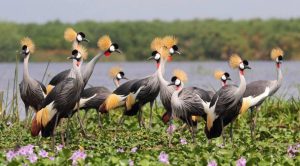Bird watching in Rwanda is very rewarding with a massive a bird list of over 750 species! Being a small country with an area cover of just 26,338 square kilometers, Rwanda contains the highest concentration of birds per square kilometer in Africa. Birding in Rwanda will reward you with a lot of bird species by covering a small area or spending a short time out on the birding trail. There is also easy access and views to the rare and hard-to-spot bird species.
Generally birdwatching in Rwanda is an enjoyable activity because of the ease to see the birds and the short distance travelled between the protected areas. More birding is along swamps by the highways and agricultural lands in the villages. A visit to Volcanoes park, Nyungwe forest and Gishwati-Mukura park will grant the best opportunities to view some of the 27 Albertine rift endemics.
When to go birding in Rwanda?
All year round! However the period from December to February is the migrant bird season during which Rwanda hosts lots of Wintering and Pelearactic migrants.
Birding infrastructure such as trails, accommodation and roads leading to the birding spots have been developed. Professional bird guides have been trained and are available to lead birding tours in Rwanda. In fact many of the prominent birding spots in Rwanda have knowledgeable site guides.
Where to go birding in Rwanda
Birding around Kigali City
Kigali is the entry point into Rwanda via the Kigali International Airport and therefore offers your first birding activity in Rwanda. There are a number of renowned birding spots within the city that for the visiting new birders provides a good introduction to some local birds of Rwanda.
Volcanoes National Park
The Volcanoes National Park protects Rwanda’s part of the Virunga mountain range, and includes five volcanoes namely Mountains Muhavura, Gahinga, Sabinyo, Bisoke, and Karisimbi. The Volcanoes National Park is famous for the Mountain Gorillas and Golden Monkeys and is mostly visited for treks to observe these endangered and endemic primates and hikes to the volcanoes. But the park boasts of about 165 bird species, 17 endemic to the area. It is must visit for birding to catch the rare species and also enjoy the breathtaking Virunga scenery and a chance to encounter the Gorillas.
Nyungwe National Park
Nyungwe National Park is a tropical mountain rainforest and lies on the south-western slopes of the highland region that forms the great divide between the Congo and Nile drainage systems. The park protects the region’s largest montane rainforest and is home to 310 species of bird.
Nyungwe is by far the most popular birding destination in Rwanda, especially being sought out for the numerous Albertine rift endemics; 27 to be found here.
Some of Nyungwe’s specials are: Regal Sunbird, Red-collared Babbler, Rwenzori Turaco, Handsome Spurfowl, Rwenzori Batis, Grauer’s Swamp Warbler, Blue-headed Sunbird, Albertine Owlet.
Akagera National Park
The Akagera National Park lies in the north east of the Rwanda, outside the high rising Albertine belt. It covers a chunk of savannah. A mix of rolling grassland interspersed with broad-leafed and acacia woodland, these lower-lying lands are dissected by the Akagera River.

 Uganda is home to over 1090 bird species making it a superb destination for bird watching safaris in Africa. The large numbers of birds in the country make up 10% of the worlds’ total bird species population wow what a great destination.
Uganda is home to over 1090 bird species making it a superb destination for bird watching safaris in Africa. The large numbers of birds in the country make up 10% of the worlds’ total bird species population wow what a great destination.